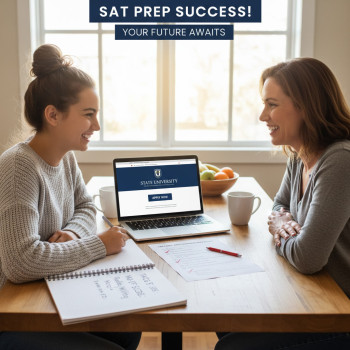Introduction: You Can Prep Well — Even with Rules
There’s a special rhythm to boarding school life: wake-up bells, study halls, lights-out policies and weekend check-ins. For many students that rhythm brings focus and community. For others, especially those balancing SAT prep, it can feel like a tight squeeze. But here’s the honest truth: a strict schedule is not an enemy of great SAT prep — it’s an ally if you learn to bend it to your advantage.
This post is for the student who’s walking past room check, packing for practice, and wondering where to fit in the hours of review. I’ll share realistic strategies that respect dorm rules, make the most of short windows, preserve sleep, and build momentum without burning out. And where individualized help fits naturally, I’ll note how Sparkl’s personalized tutoring (1-on-1 guidance, tailored study plans, expert tutors and AI-driven insights) can accelerate your progress.

Understand Your Boarding-School Constraints and Advantages
Start by mapping the routine. A clear map converts a vague stress into an actionable plan. Ask yourself and write down:
- Lights-out and wake-up times.
- Meal times, supervised study halls and free periods.
- Weekend and holiday policies that affect travel or extra-curriculars.
- Access to quiet areas like the library or teacher offices after hours.
Advantages of the environment are often overlooked:
- Built-in accountability — study halls and dormmates keep you on task.
- Predictable schedule — once you know it, you can plan habits reliably.
- Access to faculty — teachers are nearby for quick questions.
Constraints you’ll need to work around include limited private time, strict internet or device rules, and fixed lights-out. Once you accept these constraints, you can design a prep plan that fits them.
Build a Realistic Study Plan That Honors the Rules
Many students make the mistake of copying a 4-hour block study schedule they found online and trying to force it into two 30-minute windows. Instead, craft a plan around the realities of your day.
Key principles:
- Quality over quantity: forty-five focused minutes can beat three unfocused hours.
- Consistency over intensity: shorter daily practice builds skill more reliably than occasional cramming.
- Use varied modalities: mix timed practice, review, vocab work, and essay outlines to keep momentum.
How to structure it:
- Identify steady anchor times — for many boarders this is early morning before breakfast and an evening slot after supervised study.
- Slot in a longer practice once a week (a full section or a practice test segment), ideally during a study hall or on a weekend.
- Plan review sessions the day after practice tests to fix mistakes while they’re fresh.
Example weekly focus rotation
- Monday: Critical Reading strategies and targeted practice.
- Tuesday: Math problem sets and review of errors.
- Wednesday: Writing & Language mini-lessons and grammar drills.
- Thursday: Timed sections (25–35 minutes) to simulate SAT pacing.
- Friday: Vocab/word roots and light review to avoid exhaustion.
- Weekend: One full-length practice test or two long sections, plus a review.
Make Short Blocks Count: Precision Practice
When you only have 30–60 minutes, the way you use the time matters. Precision practice turns small windows into exponential learning.
- Set a single goal: “Finish 15 Reading questions and review mistakes” beats “study reading”.
- Use the Pomodoro method with micro-adaptations — 25 minutes focused on one task, 5 minutes to stretch and log mistakes.
- Keep a running error log: a one-page list of recurring mistake types and your strategies to fix them.
- End each block with a quick self-check: can you explain the rule you just practiced? If not, rework it tomorrow.
Example micro-session: 30 minutes — 20 minutes doing a timed Writing & Language passage, 10 minutes annotating the three most costly errors and writing why your answer is right or wrong.
Turn Downtime into Gains
Boarding life has built-in pockets of downtime — between classes, while waiting for meals, during quiet walks. Use these pockets for low-friction, high-return activities.
- Flashcards for vocab or math formulas — physical or app-based and short, five-minute rounds.
- Mental math while walking to class — practice operations and estimation speed.
- Listening to quick strategy explanations or read-aloud passages for reading fluency if your boarding school allows earbuds during free periods.
These micro-tasks add up. Ten five-minute reviews per day equals nearly an hour of focused review weekly — all without breaking dorm rules.
Weekend and Break Strategies: Use Long Blocks Wisely
Weekends are your chance to practice full sections or take a full-length practice test. If your school has weekend restrictions, negotiate focused study time with your dorm parents or schedule your practice during allowed library hours.
How to structure a weekend practice:
- Saturday morning: timed Reading and Writing sections back-to-back to simulate fatigue.
- Saturday afternoon: review every question you missed — don’t just mark it wrong; annotate the reasoning and note a fix.
- Sunday: light Math set and a stress-reduction activity like a walk or club practice to reset.
Make the review your priority. Practice is where you make mistakes; review is where you learn from them.
Test-Taking Techniques That Fit a Regulated Day
Pacing and endurance are crucial, especially if you can’t study late into the night to build stamina. Here are tactical habits that work within a structured routine:
- Simulate test-day conditions during your longer practice: same breaks, no devices, and the same snack choices to know how your body reacts.
- Learn question triage: spend no more than 1–2 minutes on medium-difficulty Reading questions — flag them and return after easier ones.
- For Math, translate complex word problems into bullet-point steps in the margins; structure reduces cognitive load and saves time.
- On test day, use a rigid check: after each section, jot two things you learned about pacing to improve next time.
Resources and Practice Tests Within Rules
Access to online resources may be limited by school filters. Plan alternatives:
- Download official practice tests and PDF sections when you have Wi‑Fi access and keep them on a personal device or printed packet.
- Ask teachers for supervised test slots in the library; many faculty will help proctor practice if you show initiative.
- Use shared study groups — two or three friends can run timed sections and trade reviews in a supervised common room.
Whatever resources you use, track practice test scores and the types of mistakes (content, careless errors, and timing). This tracking is the single best predictor of improvement.
Sample Weekly Schedule
The table below shows a model weekly plan that respects a typical boarding school day with lights out at 10:30pm and mandatory study halls. Adapt it to your specific schedule.
| Day | Early Morning (6:30–7:15) | Afternoon Free (3:30–5:00) | Evening Study Hall (7:00–9:00) | Weekend |
|---|---|---|---|---|
| Monday | Short Reading set (20 min) | Homework / Quick Math Drills (30 min) | Grammar practice + review (50–60 min) | Saturday: Full timed Reading & Writing + review Sunday: Full Math sections + light review |
| Tuesday | Vocabulary flashcards (15–20 min) | Problem of the day (30 min) | Timed Math section + mistake log (60 min) | |
| Wednesday | Strategy reading: passages (25 min) | Group review or office hours (30–45 min) | Mixed practice & error corrections (60 min) | Special project: full practice test every 2–3 weeks |
| Thursday | Mental math warm-up (15 min) | Teacher Q&A / problem review (30 min) | Timed Writing & Language + review (50–60 min) | |
| Friday | Light review; no new topics | Club/sports (recovery) | Quick mistake review + relaxation techniques |
Mental Health, Sleep, and the Power of Recovery
Strict schedules often prioritize order — but not necessarily student well-being. Don’t sacrifice sleep for an extra hour of midnight study; sleep consolidates memory and directly improves SAT performance. Aim for consistent bedtimes aligned with lights-out rules. If your school’s lights-out is early, tailor your study so your highest-intensity work happens when you’re sharp.
Short, intentional breaks are non-negotiable. Build in 10–15 minute resets after intense blocks — stand up, hydrate, do breathing exercises. If anxiety spikes before a practice test, use a short visualization technique: close your eyes for two minutes and imagine moving calmly through each section.
Real-World Example: How One Dormmate Improved 150 Points
Sara, a senior, lived in a dorm with a strict 10:30pm lights-out policy and mandatory study halls. She started with a 1160 and worried that the schedule didn’t allow long study sessions. Sara made three strategic changes:
- Mapped her week visually to find consistent 40-minute morning windows and three evening study-hall slots.
- Used error logs to cut repeating mistakes, focusing two weekly sessions on those specific weaknesses.
- Booked weekly teacher office hours and a monthly full practice test on available library hours.
Within three months, Sara’s practice test score rose 150 points. She emphasized that the schedule wasn’t the reason she improved — the consistency, targeted review, and smart use of available resources were. Sparkl’s personalized tutoring supported her in the second month by offering 1-on-1 sessions to prioritize weaknesses and AI-driven insights that highlighted the most impactful study targets.
How Sparkl’s Personalized Tutoring Fits Naturally into Boarding Life
Personalized tutoring can mesh smoothly with a regulated boarding schedule when used wisely. Consider these realistic ways to integrate tutoring into your routine:
- Schedule short, focused 30–45 minute 1-on-1 sessions during an afternoon free period or a supervised study hall.
- Use tailored study plans from a tutor to make every micro-session high-value — no guessing about what to practice next.
- Leverage AI-driven insights to identify recurring weak spots from practice tests so your limited study time targets the highest-impact areas.
Sparkl’s approach — expert tutors, tailored study plans, and AI-powered diagnostics — can be particularly helpful when your time is limited. The tutors’ guidance becomes your roadmap: instead of spending precious minutes deciding what to study, you open the session and execute a plan designed for your score trajectory.
Practical Checklists Before Test Day
In the two weeks before your test:
- Do 1–2 full-length practice tests under realistic conditions.
- Review every missed question and categorize why it was missed.
- Focus on sleep schedule — keep lights-out and wake times consistent.
- Create a test-day kit: pencils, calculator with fresh batteries, ID, snack, and water.
The night before:
- Do a light 20–30 minute review of high-yield formulas and strategies — not new content.
- Lay out everything you need for the morning to avoid last-minute stress.
Closing Encouragement and Final Tips
Boarding school rules can feel tight at times, but structure is the friend of steady improvement. You don’t need marathon study sessions — you need smart, consistent work and an honest record of your mistakes. Use short sessions well, harness downtime, and align your practice with your energy curve. If guidance would help, consider Sparkl’s personalized tutoring for targeted 1-on-1 support and AI-driven focus on the skills that matter most.
Finally, remember that your boarding environment gives you one big advantage: predictability. Map it, use it, and protect your rest. With a clear plan and small daily steps, the SAT becomes a manageable task rather than a looming threat. You’ve already mastered the discipline to thrive in a structured place — apply that same discipline to your prep, and the score gains will follow.


















No Comments
Leave a comment Cancel